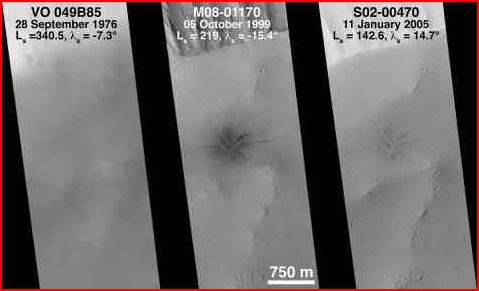
home •
about •
essential guide •
picture of the day •
thunderblogs •
news •
multimedia •
predictions •
products •
get involved •
contact

Credit: NASA/JPL/Malin Space Science Systems
pic of the day
archive
subject index
abstract
archive
Links:
Society for
Interdisciplinary
Studies
Oct 03, 2005
Lightning Strike on Mars
New craters on Mars show the unmistakable signature of electrical discharge and confirm the ongoing electrical activity of the solar system.
These images show a new crater on Mars not long after it formed and again 5 years later. The conventional explanation is that the dark streaks are “ejecta” thrown out by the “impact” of a meteoroid. Over time, the ejected material changes color to match the rest of the surface.
In the Electric Universe view, the crater is the strike point of a Martian lightning bolt. The dark rays are a Lichtenberg pattern burned into the soil as the impinging discharge channel pulls in electrons from the surrounding area. Such patterns are frequently seen around Earthly lightning strike points. Earth’s atmosphere is denser than Mars’, and it contains much more water vapor. Lightning is able to “break down” the atmosphere at much lower voltages than in the thin and dry atmosphere of Mars. So Martian lightning bolts are apt to do more damage.
This likely explains the chains of craters on the ridge to the lower right of the new crater. The chains can be traced back to the dark rays, indicating that the secondary currents that created the Lichtenberg figure were being pulled away from the surface at this greater distance, “popping” up and leaving craters behind.
The usual form of a discharge in Mars’ atmosphere is the dust devil. But both the dust devil and the crater-producing discharge scorch the surface, leaving a visible signature. The little weathering that occurs on Mars is enough to eradicate the marks over a few years.
EXECUTIVE EDITORS:
David Talbott, Wallace Thornhill
MANAGING EDITOR:
Mel Acheson
CONTRIBUTING EDITORS: Michael Armstrong, Dwardu Cardona, Ev Cochrane,
C.J. Ransom, Don Scott, Rens van der Sluijs, Ian Tresman
WEBMASTER: Michael Armstrong
Copyright 2005: thunderbolts.info